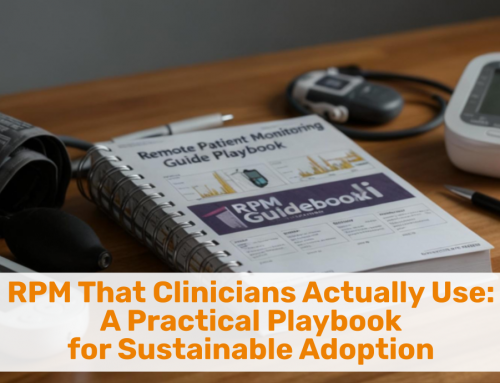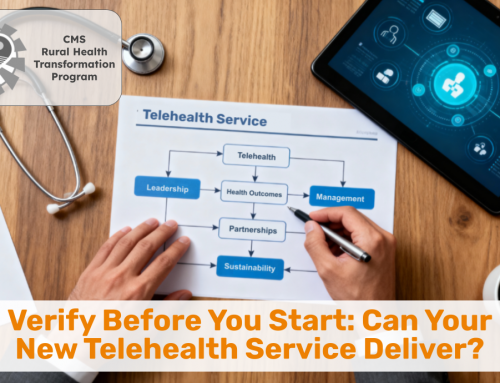Why RHTP success depends on implementation discipline, not vendor selection.
When states submitted their RHTP applications, many wisely included telehealth as a way to strengthen rural health delivery. Now those same teams face a tougher challenge: turning those commitments into real, working programs.
And that’s where the trap appears.
It’s easy to believe that once you’ve selected a vendor — whether that’s a technology vendor or a telehealth services provider — your implementation has begun. After all, that’s how proposals were written and how most vendors market themselves. But buying telehealth isn’t the same as building telehealth.
Buying telehealth isn’t the same as building telehealth.
It’s like buying surgical instruments and calling it a surgical program. The technology or the service is essential, yes — but without trained people, aligned processes, and operational leadership, it’s just stainless steel sitting on a tray.
The False Promise of the “Turnkey Solution”
Vendors often promise a smooth, out-of-the-box experience — a platform installed, a few guides provided, maybe a brief training — and call it ‘implementation.’ But that’s installation, not transformation.
Your technology vendor can’t rewrite clinical workflows, train staff across departments, or ensure patients actually use the service. And your telehealth services vendor can’t redesign your local scheduling, documentation, or billing systems to make their encounters fit naturally within your operations. That’s your job — or better yet, the job of a partner who understands the full scope of telehealth delivery.
➡️ Learn more about what your vendor can’t do for you in 5 Things Your Telehealth Vendor Cannot Do for You.
The Trap for Telehealth Services Vendors
This trap isn’t about bad vendors — it’s about blurred boundaries. Even the best service vendors operate within narrow lanes of responsibility.
Telehealth services vendors do implement telehealth — but only within the boundaries of their own offering. They can staff the virtual ED, behavioral health, or specialty care coverage. They can manage scheduling and documentation on their side. But what happens before and after those encounters often falls through the cracks.
This is where the trap lies: their implementation stops at their service boundary. The rest — integration, communication, and continuity — is up to you.
1. Their Scope Is Narrow by Design
Telehealth service vendors are focused on their operational deliverable: remote coverage, specialist consults, or on-demand visits. They don’t design your local workflows or adjust staffing patterns so your clinicians know how and when to engage with the service. Without that bridge, telehealth becomes a disconnected utility rather than an embedded capability.
2. They Don’t Own the Hand-Offs
No one is accountable for what happens before or after the telehealth encounter:
-
Who ensures the patient was scheduled correctly and consented?
-
Who captures documentation and billing?
-
Who follows up locally after the consult?
If these hand-offs aren’t clearly defined, telehealth becomes an island rather than part of the care continuum.
3. They Optimize for Their Metrics, Not Yours
A services vendor will naturally focus on what they can control — consult volume, coverage hours, response times. But those metrics don’t necessarily translate into your goals for patient access, continuity, or cost savings. That’s not negligence — it’s misalignment. The vendor’s success doesn’t automatically equal yours.
4. They Can’t Redesign Your Systems
Telehealth services vendors plug into your structure — technology, workflows, and staffing. If that structure isn’t ready, they can only operate at the margins. True implementation requires reengineering processes so the service feels native, not bolted on.
5. They Are Not Positioned to Manage Organizational Change
Telehealth services vendors operate within their service lane — not within your organization’s culture, leadership, or internal dynamics. They can deliver excellent clinical encounters, but they’re not responsible for helping your team adapt to new workflows, job roles, or patient engagement models. Change management requires inside-out ownership: aligning departments, retraining staff, and redefining accountability structures. Without that leadership, even the best vendor partnership stalls because the organization itself hasn’t evolved to support the new mode of care.
In short: even a telehealth services vendor can only implement their slice of the ecosystem. The trap is believing their readiness equals your readiness. It doesn’t.
➡️ See how telehealth success depends on addressing the complexity beyond technology.
Telehealth implementation fails when these gaps go unowned — and that ownership can’t be outsourced.
Why Telehealth Fails When You Rely on Vendors Alone
The reason isn’t lack of good technology — it’s lack of implementation expertise.
Without a comprehensive plan that addresses policy, process, and people, even the best tools and services sit idle.
We’ve seen organizations spend hundreds of thousands on telehealth solutions only to find:
-
Clinics can’t schedule virtual visits because workflows never changed.
-
Clinicians resist adoption because it adds friction, not efficiency.
-
Grant reports show “purchases made” but no measurable improvement in access or outcomes.
Telehealth is so much more than technology — it’s an organizational capability. When done right, it reshapes how care is delivered, coordinated, and reimbursed.
➡️ See why telehealth is so much more than about technology.



Implementation Does NOT Equal Installation
The hard truth: vendors sell software or services — not sustainability.
Real implementation is organizational — not transactional. A true implementation involves:
-
Workflow design and clinical integration
-
Change management and staff engagement
-
Compliance and credentialing updates
-
Patient communication and onboarding
-
Continuous optimization and outcome tracking
Those steps don’t come in the box. They require leadership, planning, and accountability — things that are outside the vendor’s scope but at the heart of your program’s success.
➡️ See what it really takes to optimize telehealth beyond technology.
The Real Risk for RHTP Grantees
RHTP funding isn’t a blank check — it comes with strings, and CMS can pull them back.
The NOFO makes it clear that states must demonstrate performance and sustainability. If initiatives underperform or fail to meet their approved commitments, CMS may withhold or even recover funds.
That means a poorly executed telehealth program doesn’t just stall progress — it could jeopardize current and future funding.
But the greater risk isn’t just financial — it’s systemic. Telehealth done hastily, with fragmented workflows or untrained staff, leads to underuse, poor outcomes, and no measurable ROI. And those are exactly the metrics CMS will use to judge RHTP performance.
The reality is that success under RHTP will hinge on implementation maturity — not the number of licenses purchased or vendor contracts signed. To sustain funding and results, states need a telehealth strategy that builds capacity, integrates across care settings, and demonstrates clear impact.
That’s where a smarter approach begins — one that views vendors as partners in a broader implementation effort, not as turnkey solutions.
The reality is that RHTP success will hinge on implementation maturity — not the number of licenses purchased or contracts signed. Sustained funding depends on measurable results, and that means building capacity, integration, and accountability into every telehealth initiative.
💡 A Smarter Approach
Avoiding those risks requires structure — a deliberate, stepwise approach that treats implementation as a system, not a purchase.
The smartest approach isn’t to start with a purchase — it’s to start with a plan.
Telehealth implementation succeeds when it follows a structured, phased process that builds understanding first, designs for fit second, and brings in vendors only after the foundation is set.
Phase 1: Listen and Learn
Every successful implementation begins by listening — to clinicians, administrators, and patients. Understanding the real barriers, workflow gaps, and service needs allows states to target high-impact telehealth use cases instead of defaulting to generic solutions.
Yes, that takes time — and 21 months isn’t much time to show results. But as the adage goes, sometimes you need to go slow to go fast. Implementing the wrong thing fast never earns awards.
And given our deep familiarity with over 85 proven telehealth solutions, this process for the initial set of services will take weeks, not months.
Phase 2: Design and Develop
Once priorities are clear, the work shifts to defining how each service will function in context. That means building the strategic, clinical, and business case; mapping workflows; aligning policy and reimbursement; and designing the technical and operational requirements.
Only then does vendor selection occur — as one deliberate step in a larger process, ensuring the chosen technology or service aligns with what the system actually needs — not the other way around.
Phase 3: Implement and Optimize
After design and vendor alignment come training, validation, deployment, and continuous improvement — the work that turns intent into sustained capability. This phase is where success is measured not by “go-live” dates but by outcomes: utilization, satisfaction, and sustainability.
A Systems Approach: Telehealth thrives when it’s built, not bought. By following this systemic, phased approach, states can ensure their RHTP telehealth initiatives deliver measurable impact, avoid costly missteps, and meet CMS’s expectations for long-term performance.
Are you Implementing Telehealth?
Then don’t buy telehealth.
Build telehealth — with the right strategy, the right people, and the right partners.
Vendors can supply the technology or the service, but successful implementation happens at the point of care. It takes skilled operational teams within hospitals and clinics — guided by experts like Ingenium — to integrate telehealth into daily workflows and build systems that deliver lasting results.
If you’re involved in your state’s RHTP program administration, we’ve developed a comprehensive RFP template to help states engage qualified partners who can deliver telehealth the right way — sustainably, systematically, and successfully.
Contact Christian for a copy of the RFP template to help your state engage qualified implementation partners.








To receive articles like these in your Inbox every week, you can subscribe to Christian’s Telehealth Tuesday Newsletter.
Christian Milaster and his team optimize Telehealth Services for health systems and physician practices. Christian is the Founder and President of Ingenium Digital Health Advisors where he and his expert consortium partner with healthcare leaders to enable the delivery of extraordinary care.
Contact Christian by phone or text at 657-464-3648, via email, or video chat.






